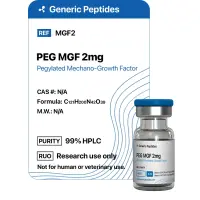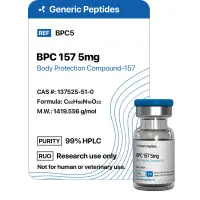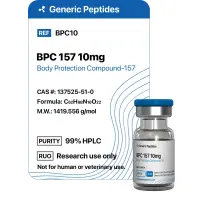- Active Substance: 5-Amino-1-methylquinolinium
- Concentration: 50 mg per vial
- Pack Size: 1 vial
- Manufacturer: Generic Peptides
- Brand Name: 5-Amino 1MQ
- Synonyms: 5-A-1MQ, 5A1MQ
- Molecular Formula: C10H11N2
- Molecular Weight: ~159.21 g/mol
- Mechanism: NNMT Inhibitor, NAD+ Preservation
Shipping From
5-A-1MQ 50 mg – NAD+ Modulation & Fat Loss Research Compound
Product Information
5-A-1MQ (5-Amino-1-methylquinolinium) 50 mg is a potent research compound known for its activity as an NNMT (Nicotinamide N-methyltransferase) inhibitor. This action helps preserve intracellular NAD+ levels, a coenzyme essential for mitochondrial energy production and cellular repair. Supplied in a 50 mg vial, this formulation from Generic Peptides ensures reliable dosing for in-vitro or experimental studies on fat metabolism, insulin resistance, and aging. Researchers exploring mechanisms of metabolic enhancement, calorie restriction mimetics, and NAD+-driven longevity pathways often incorporate 5-A-1MQ into their protocols. Its low molecular weight and high bioavailability make it an ideal candidate for experimental delivery systems.
Product Description
5-A-1MQ 50 mg is a non-peptide small molecule that may exert profound effects on systemic metabolism by downregulating NNMT, an enzyme that depletes NAD+ reserves. NNMT activity increases with age and obesity, contributing to metabolic decline. In research settings, inhibition of this enzyme by 5-A-1MQ is hypothesized to improve glucose tolerance, enhance mitochondrial function, and reduce adiposity. The 50 mg strength is ideal for dose-dependent investigation and longer-term metabolic studies. This compound may serve as a valuable tool in preclinical models studying fat metabolism, mitochondrial efficiency, and NAD+ biogenesis.
Mechanism of Action
5-A-1MQ functions by inhibiting the NNMT enzyme, which plays a role in the methylation of nicotinamide—a key substrate for NAD+ synthesis. By blocking this pathway, intracellular NAD+ levels are preserved or restored, promoting sirtuin activity and mitochondrial biogenesis. Elevated NAD+ supports improved cellular energy output, DNA repair, and neuroprotection. In fat metabolism studies, this mechanism may enhance lipolysis, improve insulin sensitivity, and reduce visceral fat. The compound's ability to modulate multiple energy-related pathways makes it highly valuable for investigations in metabolic health and aging-related decline.
Use Case
From a Clinical Pharmacologist's perspective, 5-A-1MQ offers a novel mechanism of action that targets upstream metabolic regulators. It could be hypothetically used to restore NAD+ levels in aging populations or individuals with metabolic syndrome. Research models have shown promise in applications related to fat loss, insulin sensitivity, and energy metabolism restoration. It is especially valuable for evaluating non-hormonal strategies to activate similar outcomes seen in calorie restriction or endurance exercise. These benefits may have far-reaching implications in the study of obesity, type 2 diabetes, neurodegeneration, and biological aging.
FAQ
What is 5-A-1MQ used for in research?
5-A-1MQ is used in studies exploring NAD+ metabolism, fat loss, insulin sensitivity, and cellular energy regulation. It is often tested for its potential in age-related metabolic decline and obesity research.
How does 5-A-1MQ affect NAD+ levels?
By inhibiting the NNMT enzyme, 5-A-1MQ reduces NAD+ degradation, helping to preserve or enhance intracellular NAD+ levels. This boosts cellular energy and supports mitochondrial function.
Is 5-A-1MQ safe for human use?
No. 5-A-1MQ is for research purposes only and not approved for human consumption. It is not FDA-evaluated for safety or efficacy in humans.
Legal & Compliance
This product is intended strictly for laboratory and research use only. It is not approved for human consumption, therapeutic, diagnostic, or clinical use. All buyers must be qualified professionals or institutional researchers. Misuse or off-label application is strictly prohibited and may violate U.S. federal and local laws.




